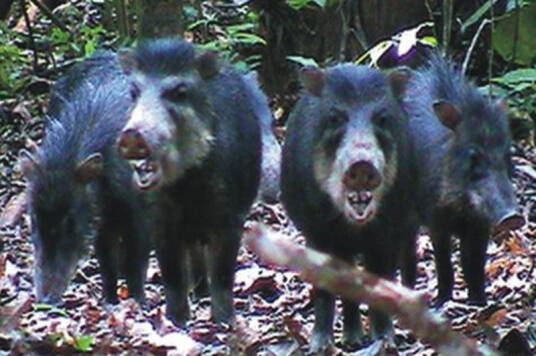Pecari maximus
IUCN
LCBasic Information
Scientific classification
- name:Pecari maximus
- Scientific Name:Pecari maximus,Pecari Gigante,Giant wild boar
- Outline:Ungulata
- Family:Artiodactyla Peccary
Vital signs
- length:120-137cm
- Weight:40-50kg
- lifetime:16-24years
Feature
The peccary is larger, has longer legs, and is smaller in proportion than other members of the genus.
Distribution and Habitat
Distribution: Amazonia, South America, including south-central Amazonia and northern Bolivia between the Madeira and Tapajós rivers, reaching the eastern side of Madidi National Park. It is restricted to permanent terrestrial forests.
Appearance
The giant peccary has a head-body length of 120-137 cm, while local hunters estimate the weight to be 40-50 kg. It is the largest wild boar in the world, the same size as a large dog. It has a huge body, thin legs, and a head that is smaller than the torso. The hair is uniformly black. According to its original description, the giant peccary is larger, has longer legs, and is proportionally smaller than the only other member of the genus, the collared peccary. Compared to the collared peccary of the same group, the giant peccary has thinner fur, brown and white in color, black legs, and a relatively faint collar.
Peccaries are hoofed animals similar to pigs, but have some advanced characteristics, and their stomachs are more complex than those of pigs, with a compartmentalized stomach. Living with only 1-2 offspring in a litter, peccary males are much smaller, weighing 20-30 kg, but giant peccaries can reach 40 kg. Measurements of the giant peccary's body and skull confirmed th
Details
Pecari maximus (scientific name: Pecari maximus) is also known as Pecari Gigante in English. It has no subspecies.

The giant peccary is a large forest-dwelling wild boar first discovered in 2000 by Dutch naturalist Marc van Roosmalen in the Rio Aripuan Basin in Brazil. In 2003, he and Lothar Frenz, a journalist from the German Museum of Natural History, managed to film a group of giant peccaries and collect some data, which was later used as the final conclusion of the new species. The new species was placed in the genus Pecari and named "Pecari maximus". Although the species was not scientifically defined until recently, the giant wild boar was known to local people and settlers, who hunted the species for its meat and called it Caitetu Munde, or "pair-living giant pècari". The giant peccary was officially described and scientifically recognized in 2007, but the species status is still poorly understood.
Animals of the family Pecaridae are extremely aggressive. They usually live in groups of dozens to hundreds and attack predators in groups, inflicting severe wounds with their long, sharp tusks. They can even kill jaguars and humans. The giant peccary is different from other members of the same family in that this animal lives only in small family groups consisting of a pair of parents and 1-2 offspring. It lives in the jungle between the Madeira and Tapajós Rivers. Other peccary species, like pigs, prefer to eat tubers and roots of plants, while the giant peccary feeds mainly on fruits and is less obsessed with tubers. The glands of the giant peccary are more active than those of other wild peccaries and are used to mark territories and distinguish one from another.
Based on DNA analysis, collared peccaries and giant peccaries are estimated to have diverged 1.0-1.2 million years ago, but these findings are considered problematic due to low bootstrap support, small sample size, and lack of DNA and cytogenetic results. In addition, extensive intraspecific variation (individual-based and location-based) is known in the morphology of collared peccaries. The scientific evidence of the species status of the giant peccary was later questioned, which is one of the reasons why the IUCN assessment data was insufficient.
Protect wildlife and eliminate game.
Maintaining ecological balance is everyone's responsibility!








